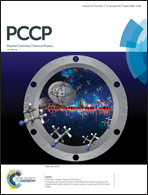Hierarchical nitrogen-doped porous graphene/reduced fluorographene/sulfur hybrids for high-performance lithium–sulfur batteries
Abstract
It is a great challenge to obtain high performance cathodes with a high sulfur loading and good cycle performance due to the dissolution of intermediate lithium polysulfides in lithium–sulfur batteries. Herein, we report a novel hierarchical hybrid composed of nitrogen-doped porous graphene (NG), reduced fluorographene or graphene fluoride (RFG), and sulfur as a composite cathode in the Li–S batteries. In comparison with sulfur composites based on only either nitrogen-doped porous graphene or pure reduced fluorographene, the hierarchical hybrid of RFG, NG, and sulfur (NG–RFG/S) shows a better reversible capacity and rate capability performance due to a better confinement effect of lithium polysulfides and sulfur. The NG–RFG/S cathode with ∼63.2% S content exhibits a high discharge capacity of 1120 mA h g−1 and retains 632 mA h g−1 after 100 cycles at 0.1C. At the higher rate of 0.5C, the cell still maintains a discharge capacity of about 300 mA h g−1 after 800 cycles, which reveals the great potential of this hybrid cathode for long-cycle-life, high energy density storage applications.



 Please wait while we load your content...
Please wait while we load your content...